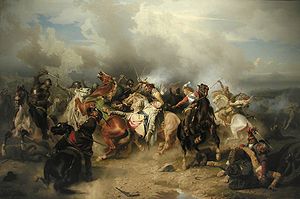Wikipedia:WikiProject Military history/Military conflict infobox
Military conflict infobox[baguhin ang wikitext]
| Battle of Lützen | |||||||
|---|---|---|---|---|---|---|---|
| Bahagi ng the Thirty Years' War | |||||||
 The Battle of Lützen by Carl Wahlbom shows the death of King Gustavus Adolphus on November 16, 1632. | |||||||
| |||||||
| Mga nakipagdigma | |||||||
|
Sweden, Protestant German states |
Holy Roman Empire, Catholic German states | ||||||
| Mga kumander at pinuno | |||||||
|
Gustavus Adolphus †, Bernhard of Saxe-Weimar |
Albrecht von Wallenstein, Gottfried zu Pappenheim † | ||||||
| Lakas | |||||||
|
12,800 infantry, 6,200 cavalry, 60 guns |
10,000 infantry, 7,000 cavalry, 24 guns | ||||||
| Mga nasawi at pinsala | |||||||
|
3,400 dead, 1,600 wounded or missing | 3,000–3,500 dead or wounded | ||||||
A military conflict infobox (sometimes referred to as a warbox) may be used to summarize information about a particular military conflict (a battle, campaign, war, or group of related wars) in a standard manner.
The infobox should be added using the {{Infobox Military Conflict}} template, as shown below:
{{Infobox Military Conflict
|conflict=
|partof=
|image=
|caption=
|date=
|place=
|casus=
|territory=
|result=
|combatant1=
|combatant2=
|combatant3=
|commander1=
|commander2=
|commander3=
|strength1=
|strength2=
|strength3=
|casualties1=
|casualties2=
|casualties3=
|notes=
}}
- conflict – the name of the conflict being described (e.g. "Battle of Lützen" or "World War I").
- partof – optional – the larger conflict containing the event described in the article. For battles or campaigns, this should be the war during which the event takes place; for particularly large wars, this may include a theatre (e.g. "the Eastern Front of World War II"). For wars, the parameter may be used to link to a larger group of wars (e.g. the Italian War of 1521–26 to the Italian Wars). It may be necessary to insert "the" before the name of the war for proper grammar.
- image – optional – an image for the warbox. The image must be given in the form [[Image:Example.jpg|300px]]; in particular, the thumb attribute must not be selected.
- caption – optional – the text to be placed below the image.
- date – optional – the date of the conflict described. Convention is to give the actual date for battles and the years for wars, but this does not always apply.
- place – the location of the conflict. For conflicts covering a wide area, a general description (e.g. "France", or "Europe", or "Worldwide") may be used.
- casus – optional – the formal casus belli of a war. This field should not be used for battles, for the underlying causes of a war, or in cases where the casus belli is disputed and requires a lengthy explanation.
- territory – optional – any changes in territorial control as a result of the conflict; this should not be used for overly lengthy descriptions of the peace settlement.
- result – the outcome of the conflict (e.g. "French victory"). Modifiers such as "inconclusive" or "decisive" may be used as necessary.
- combatant1/combatant2/combatant3 – optional – the parties participating in the conflict. This is most commonly the countries whose forces took part in the conflict; however, larger groups (such as alliances or international organizations) or smaller ones (such as particular units, formations, or groups) may be indicated if doing so improves reader understanding. When there is a large number of participants, it may be better to list only the three or four major groups on each side of the conflict, and to describe the rest in the body of the article. The combatant3 field may be used if a conflict has three distinct "sides", and should be left blank on other articles.
- commander1/commander2/commander3 – optional – the commanders of the military forces involved. For battles, this should include army commanders (and other officers as necessary). For wars, only prominent or notable leaders should be listed. Ranks and position titles should be omitted. The {{KIA}} and {{POW}} templates may be included immediately after the names of commanders who were killed in action or surrendered and were taken prisoner, respectively. The commander3 field can only be used if the combatant3 field is set.
- strength1/strength2/strength3 – optional – the numerical strength of the units involved. It is generally not useful to provide unit names without giving an indication of numbers. The strength3 field can only be used if the combatant3 field is set.
- casualties1/casualties2 – optional – casualties suffered, including dead, wounded, missing, captured, and civilian deaths. Terms such as "dead" (or "killed"), "wounded", or "captured" should be used in place of abbreviations such as "KIA" or "POW".
- casualties3 – optional – if combatant3 is set, this is a third casualty field identical to the two above; if it is not set, this is an alternate combined field for use where only the total casualties of a conflict are known, or where civilian casualties cannot be directly attributed to either side.
- notes – optional – optional field for further notes; this should only be used in exceptional circumstances.
